I bolted awake at 1:15am to a shrieking alarm. We were 50 miles south of the Grand Banks, in large seas, on passage from Newport, RI to Kinsale, Ireland. I ran upstairs to the pilot house and Jennifer, at the helm, just said “high bilge water.” Yuck. Better than fire but far from good news. I ran back down stairs to get to the engine room and, yes, conditions there certainly do warrant a high bilge water alarm. I hadn’t even stopped to put clothes on yet but in the short time between the alarm firing and me arriving in the engine room, the water had come up above the bilge and the port side engine pan that forms the walkway around the engine was already awash.
The rest of the story is up at Alarms at 115am. The quick summary is we got the problem resolved, but it took 11 hours, and we learned about a few changes we could implement that would make Dirona safer. It’s been six months since that morning with the alarms and we now have all the changes implemented. This write up is about what we decided to do.
The first issue is the aft storage lockers will flood in very rough sea conditions. This by itself isn’t really a problem. The things we store in that locker can get wet, but the real problem is, if that locker fills up a few inches, water will flood down below through the shore power cord re-tractor storage opening. This raises two questions: 1) why is the locker filling? and 2) why will a flooded locker allow large quantities of water into the boat?
The locker is filling because it has a one-inch drain hole. We have had the boat for eight years and we often see some water in that locker, but rarely much and it hasn’t been flooding below. The locker drain is there to help nuisance water get out so the locker contents don’t stay wet all the time. This actually works fine, but every year or two a wave fills the cockpit and, when this happens, the locker floods through the “drain” and some water gets below. On the night in question, the sea conditions were both fairly severe and quartering, and the cockpit was filling every 60 to 90 seconds. This means there was always 12 inches of water in the cockpit so the locker would eventually have 12 inches of water as well.
The flooded locker was dumping large quantities of water into the boat through the down the 2-inch Glendinning shore power cord retractor pipe that passes through the locker floor. The pipe has a collar around it to help keep water out but, in these conditions, water was just about always above the collar. Once the locker has more than 1.5-2 inches of water, it floods below. Under these fairly rare conditions, we essentially have the 1-inch drain hole from the cockpit pouring directly into the boat. A 1-inch hole at 1 foot of depth will bring in 19 gallons per minute or 1,140 gallons per hour (from: http://www.whsyc.org/Flooding/Flooding.html). This doesn’t sound like much until you see how fast the engine room fills.
We addressed this problem in two different ways. First, we installed small boat self-bailing transom plugs. These are essentially one-way valves that allow a small boat to seal when it’s sitting in the water but to allow bilge water to drain out when the boat is up on plane. We put one on each locker and these valves will allow water to freely drain from the locker but, in those times when the cockpit fills, water will not run into the locker. This means the locker will be clear and dry under normal circumstances and won’t be allowed to fill when the cockpit does. Thanks to mvdirona.com blog readers Greg Moore and Dave Berliner who recommended this approach.
This check valve seems like a pretty effective solution but we also added an extra level of redundancy. For this we sealed off the shore power cable retractor hole using an alpine boot gaitor. Gaitors, for those that haven’t used them, are waterproof boot extensions that can be wrapped around your leg and velcroed together to prevent water from rushing down your boot tops when walking through snow or high water. We installed one on the cord retractor hole. Strictly speaking it should never do anything but, if for any reason, the locker flooded, this would reduce the flow below to a trickle if any at all. Thanks to mvdirona.com blog readers Rod Sumner and Paul Wood who suggested this mitigation.
At this point, we’re back to our usual dry bilge. We keep the bilge dry so we can see any leaks quickly. We also test the bilge pumps annually but part of the problem was the main bilge pump had a failed valve. These Jabsco 34600-0010 pumps have a few weak points, the most annoying of which is the inlet and outlet valves have ferrous metal rivets that hold the rubber flapper in place. Unsurprisingly, these valves fail and testing annually really isn’t sufficiently frequent. But, even if you test them daily, they can still fail an hour later. The only way to trust these pumps is to change the valves frequently.
We considered that option but it doesn’t seem practical or efficient and the valves are fairly expensive. Instead, we installed a Rule 3700 in the main bilge with an automatic float valve only a couple of inches above the often-faulty Jabsco pump. We initially planned to use a Rule 4000, but the 3700 was a better fit in what is a very tight spot. We already did have a Rule 3700 high-water bilge pump installed that produces excellent volume (our bilge pump design is described at Fighting Water Ingress). But we learned from this incident that it is mounted way too high in the bilge to serve as a primary high-volume dewatering system since it doesn’t even turn on until the main bilge is nearly full. It’s tough to see that much water in the bilge and feel like things are still under control. We left it in place as an additional level of redundancy.
We now use the Jabsco 34600-0010 pump only to dry the bilge. If there is more than a couple of inches of water, the Rule 3700 takes over and it’s capable of moving 3700 GPH. It moves a lot of water. So much that the original leak would have just turned on this pump every 2 or 3 min for 15 to 20 seconds and would easily have handled this leak.
Fortunately we have two very loud bilge alarms since one of them didn’t work that night. We suppose this is fine since the reason we have redundancy is we want to be absolutely certain one will work. But, for something this important, we ended up deciding we wanted to have three high water detectors so we installed yet another one.
Closely related to the bilge high water alarms, we also have pump cycle counters mounted on the dash, but we wanted to make sure these absolutely get noticed. Now when the bilge pump cycles more than 3 times in 1 hour, our control systems will illuminate a red warning light on our Maretron N2kView display and send email to both of us.
For added safety, we added a red warning light in the engine room when the new Rule 3700 bilge pump operates, and a manual switch allowing the pump to be operated by hand if the automatic float fails. And when the pump operates, the control system will send email, generate an audible alarm, and display an indicator light on our Maretron N2kView display.
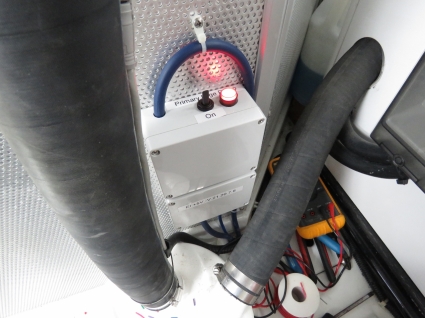
|
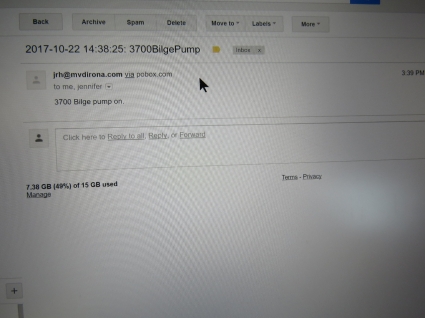
|
We also have a Pacer SE2IBL hydraulic bilge pump that can move a prodigious 180 gallons per minute. It’s a beast, but is not self-priming, so care is needed to pump out the bilge without pumping down to the point where the prime is lost. We get great security from the volume of water it can move but, ironically, its volume is a problem as well. You need to turn the pump on, dump the water, then shut it quickly off again. This is easy if you can watch it pumping, but the switch that controls it is up in the pilot house so what should be a simple job ends up taking two people. We installed a second control switch in the engine room so the pump can be operated by a single person with a view of the bilge. Of course, it’s also controllable from the pilot house.
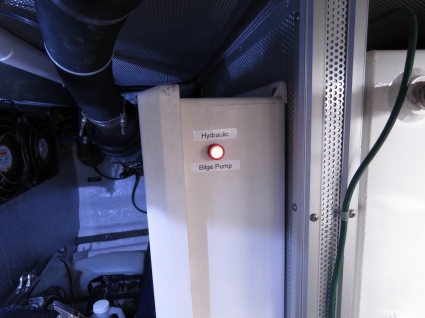
|
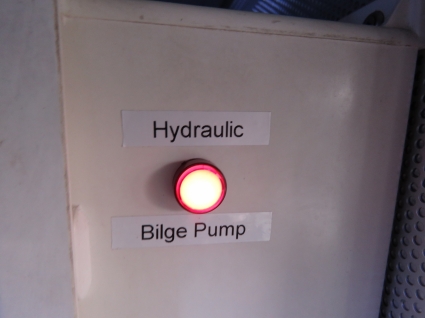
|
When we said earlier “we installed a Rule 3700”, we oversimplified slightly. It actually doesn’t fit in our bilge. Access to the lower bilge in our boat is limited below the prop shaft and 5 through-hulls. The pump can’t be dropped in through all that mechanical gear so it needs to be assembled in place like a ship in a bottle. In order to install the pump, the base had to be removed and then it had to be worked into the bilge but held high enough that the base and float valve can be installed. Then the outlet plumbing had to be installed and the pump lowered to its operating point at the bottom of the bilge. Each section of the outlet plumbing had to be added in sections since the entire assembly is too large to install in a single operation.
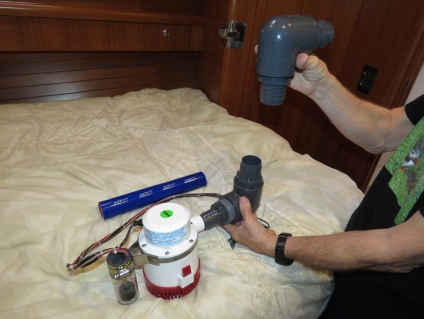
|
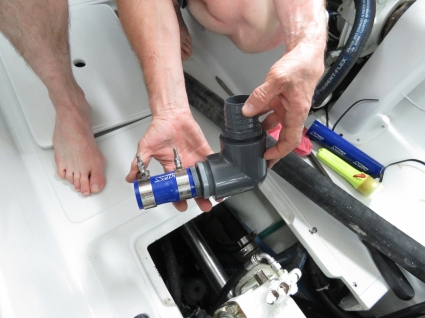
|
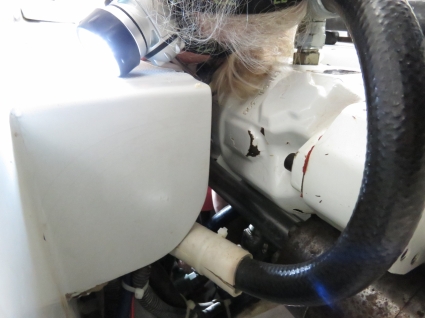
|
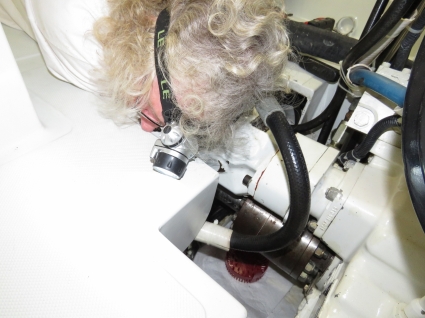
|
In the pictures you can see some of the obstructions but it’s hard to do them all justice. The bilge is just barely wide enough for the pump at the bottom. Halfway up, there are through hulls for the generator, wing engine, hydraulics, and HVAC cooling. Above those near the top of the bilge is the 2 1/4-inch main prop shaft. Once installed, the Rule 3700 fits nicely and works super well
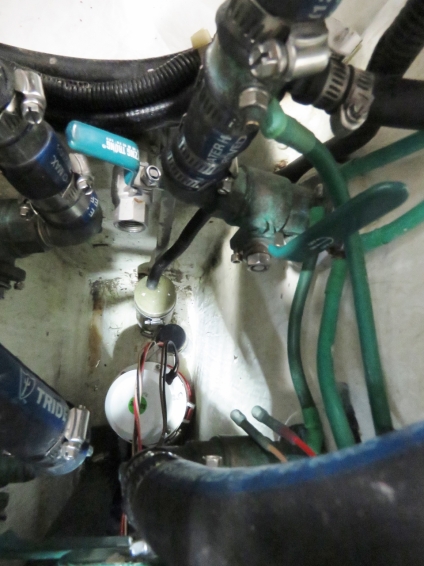
|
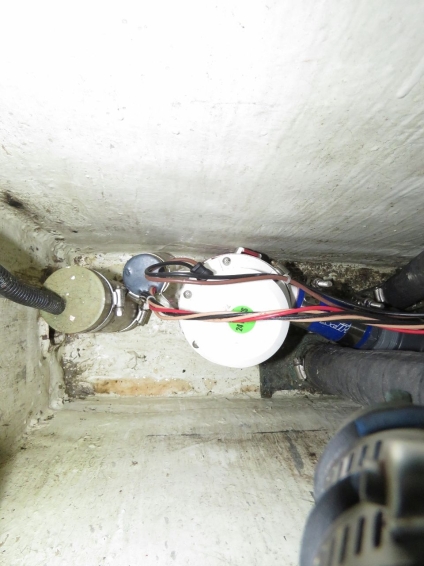
|
Due to tight quarters in the main bilge, the design we chose for discharge is to have the new bilge pump share the 2-inch pump hose with the manual bilge pump. We put the manual bilge pump and the 3700 in series rather than in parallel. Essentially the 3700 replaces the pickup for the manual pump and discharges inline through the manual pump. And the manual pump draws through the 3700 pump.
It’s an unusual configuration, but we’ve filled the bilge and the manual pump output is indistinguishable from the test prior to installing the 3700. We again filled the bilge and the 3700 output is about 3x and perhaps 4x the output of the Jabsco pump. It’s a simple design that seems effective and is fairly easy to install. Well, it would be “easy” except for having to install the pump like a ship in a bottle. That required some patience but, otherwise, the job actually was easy.
In the first picture below, James is starting the Rule 3700 install by pulling up the extremely stiff hose from the manual bilge pump that we’ll use as the discharge hose for the new pump. The second picture shows the grate at the end of the hose where the manual bilge pump picks up from the bottom of the bilge. We cut off that grate and plumbed the hose into the new Rule 3700.
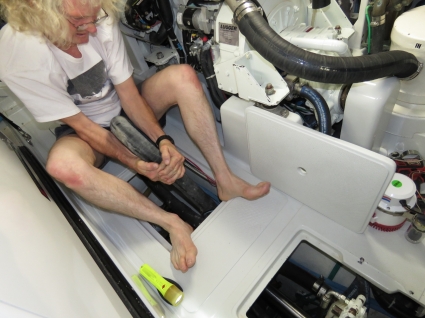
|

|
In summary, the changes we made to address this issue were:
- insert self-bailing transom plugs on the two cockpit locker drains
- seal off the shore power cable retractor hole with an alpine boot gaitor
- don’t rely on the low-volume and low-reliability Jabsco 34600-0010 for anything more than bilge drying
- install an additional Rule 3700 just above the main bilge-drying pump
- illuminate a red warning light in the engine room when the new Rule 3700 bilge pump operates
- when then new the pump operates, the control system will send email, generate an audible alarm, and display an indicator light on our Maretron N2kView display
- install a third bilge high-water detector
- when the bilge pump cycles more than 3 times in 1 hour, our control systems will illuminate a red warning light on our Maretron N2kView display and send email to both of us.
- install a second hydraulic bilge pump control switch in the engine room for single-person operation.
In many ways, this is a lot of work for a problem that only happened once in 7 years. But this is life critical equipment and we intend to own the boat for many more years to come, so it feels worth it.
2019.02.20 Update
The Jabsco 34600-0010 bilge pump has sufficient quality and volume problems that we replaced it with a Whale Gulper 320 High Capacity bilge pump. More ….
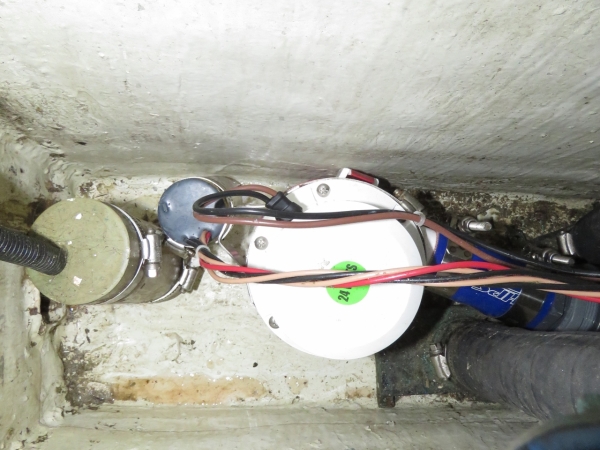
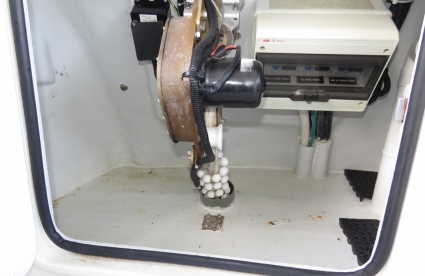
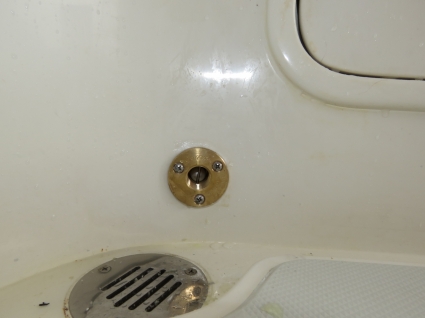
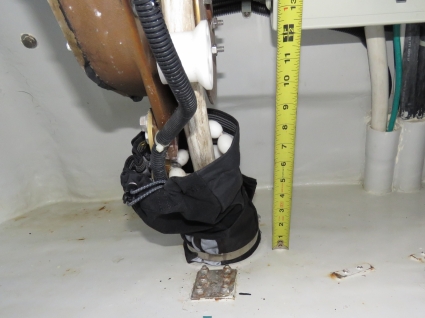
As your boat ages you may want to consider a near disaster I experienced. I have two Rule 3700 pumps, one in the aft bilge and one forward bilge connected with a 1” pipe. We were offshore fishing in choppy weather and I noticed the boat acting sluggish. A thru-hull failed and we had a 1” opening to sea. Both pumps were running but not pumping. Turns out small pieces of gel coat bilge paint had cracked and chipped into the bilge and plugged the slots in the Rule pump base and plugged the intakes. It doesn’t take much debris to foul these pumps. At the time I didn’t have bilge alarms which might have helped me avoid clearing pumps with my head submerged in the bilge. Wrapping the pumps in a large brass mesh screen helps avoid this issue.
Greatly appreciate all your wisdom and experiences shared. Respect your methodical and calm approach to issues.
Yes, build debris is a very real risk of plugging bilge pumps. What we do is spray water everywhere we can reach on a warm day and then run the engines and HVAC to heat and dry the boat again. We do all we can to flush the debris out when its not an emergency but it still can be a problem and you have to be prepared to clean them in an emergency situation.
The number 1 most important step you can take is a bilge alarm. You need to know if you are accumulating water in the bilge and not knowing it until the boat feel sluggish is a common way to lose a boat and sometimes the crews. This is so important you should have more than 1. We have three on Dirona and test them annually. I also recommend alarming on bilge pump cycles — if there are more than N cycles in an hour, alarm.
Hi James: I have been thinking about your sump pump configuration and the changes you made after the water infiltration situation you encountered when crossing the Atlantic. The N63 is set up differently than the N52 obviously. I have a main sump that has the Jabsco sump pump and also a pickup foot for a hydraulically operated sump pump, both aft of the main engine, which I think is like you on the N52. In addition to this, I have a high-water Rule pump in a sump forward of the main engine at a higher level than the main sump. So if the Jabsco can’t keep up and the water level rises, the forward sump fills up and the Rule high-water pump kicks in. I know this works as I had a condition where a hose blew off the fresh water pump causing my 800 gallon water tank to fill the interior of the boat. As the Headhunter Mach 5 fresh water pump puts out way more water than the small Jabsco can handle, the sump filled up such that the high-water Rule pump in the forward engine room kicked in until the two pumps had the situation under control.
So I am thinking that I don’t need to add another Rule pump in the main sump at a higher level like you did as I have that covered already with my Rule pump in the forward engine room. I wish it were at a lower elevation to kick in earlier, but the arrangement does work. I also have another high-water Rule pump (higher yet than the one in the forward engine room) in the forward basement (bow of the boat) that would kick in if the water situation really got dire. So I think I am okay…any thoughts?
Like you, I also have a fairly extensive Maretron monitoring system that contains high water sensor alarms in various locations, including one in the main sump aft engine room. I like your idea of a redundant sensor in that location should the other sensor fail. Question…did you connect to the two sensors to the same SIM100, or for true redundancy, do you have them going to different SIM’s? Again, I do have some “alarm” redundancy in that the same main engine room bilge that has the Jabsco pump and the pump float switch both tied into a RIM100 which are set to alarm when those two components are triggered. So in effect, I have three “alarms” in the main sump comprised of the float switch running, the Jabsco pump running & a high water level sensor that would all go off should a high water event take place. Therefore, not sure I need another high-water level sensor…your thoughts?
Thanks.
Tim
Piredmus N63-06
Your system sounds carefully thought out and well executed. Some thoughts and answers:
*Alarms: On fire detection and bilge alarms, I like a lot of redundancy. On bilge alarms, we have three independent systems: 1) Maretron alarm using SIM100, 2) Ultra Safety systems, and 3) Separate Ultra Float switch driving an alarm independent from the Maretron or Ultra Safety Switch alarm. The later is directly driven off the battery with a dedicated circuit breaker (described in more detail below in the automatic pump section).
*Manual pumps: The pacer is able to drive massive volume but it is manual (needs to be turned on/off), needs to be primed, and will overheat and fail quickly if run dry. Because of the later two points, I think it’s best to keep the pacer manual. You need to ensure it gets a good prime and have to ensure it doesn’t run dry which will both lose prime and overheat the pump. Two tricks to ensure prime in a pacer: 1) put RV antifreeze in the pump since it won’t evaporate, or 2) put a freshwater pressure system attachment into the top of the pump and open the valve prior to fill the pump prior to starting it.
*Automatic pumps: As much as I love manual pumps, automatic pumps are the most important and we want massive capacity on pumps that require no attention and just run without human intervention. Of course we want the monster manual Pacer pump as well but, ideally, we would never use it. The fact that the Pacer has been used twice is evidence we didn’t have sufficient automatic capacity. We now have a Gulper 320 as the first level of defense. An inch above that we have a Rule 3500. A foot or so above that we have a second Rule 3500. The lowest Rule 3500 that is just above the Gulper gets a battery feed directly from the battery with it’s own private breaker and a very direct wiring unlikely to be effected by problems elsewhere in the system. The single breaker is alarmed so if it opens, the full boat alarm goes off. If that pump has no power, the full boat alarm goes off. If the pump cycles, warning lights in the PH go off. If it cycles more than 3 or 4 times in an hour, the full boat alarm goes off.
*Testing: We do an annual test where we fill the bilge and test that each alarm fires and each pump turns on as it should. We disable pumps once they are proven correct to test the pumps above and, when done, turn everything back on and ensure it all works together.
I love the NMEA2000 system and use it for lot and depend upon it for monitoring but it’s important to have key alarms redundant outside of the NMEA2000 system so you still get warnings if the system fails. On our boat, we have fire detection, bilge alarms, and generator auto start both on Maretron but also independent of it. If any of these system have any issues, we trigger alarms, send email, light indicators, etc.
I would recommend replacing the Jabsco dewatering pump with a Gulper 320. It’s simpler, less expensive, and far more reliable. Both can run dry and be mounted outside of the bilge.
James, I’m using N2Kview with a RIM100 to monitor my bilge activity. I’ve been unable to figure out a way to set an alarm if the bilge cycles x times in a given time period. In other words if my bilge pump cycles 5 times in an hour it’s a concern for me that I want my PH alarm to go off but if the 5 cycles are over a 7 day period it’s not a concern. If there was an automatic way to periodically reset the cycles/runtime then a setting up an alarm would be fairly easy but I haven’t seen this functionality with N2KView. Are you doing this alarm triggering within N2Kview or doing some other processing outside this system?
Maretron N2kview can do many of the monitoring and alarming tasks we use on Dirona but not the one you want in this particular case: alarming if more than N bilge pump cycles in a X min period. I agree that is a great way to avoid nuisance alarms and but still get very quick visibility into more serious bilge water leaks.
We use and love N2kview for monitoring but the alarming isn’t rich enough for our uses so we did that separately using custom code. Because N2kview can trigger an external circuit (also called digital output) and it can sense external events (also called digital input), you can signal external logic when the bilge pump cycles and the external logic can keep track of time and bilge pump cycles and send a signal back into N2kview to alarm when the conditions have been met. The Maretron SIM100 can do digital input and the DCR100 can do digital output.
So, what you want is possible but it’s a bit of work. An alternative is to search the web for “bilge counter and alarm” and see if any of the commercial systems meet your needs.
James, thanks for confirming you were doing the logic outside of N2KView. I like N2KView but it has certain limitations. I’ve been racking my brain trying to figure out how to do the x cycles in 1 hour within N2KView and thought I might be overlooking a way to do this. I recognize you sold Dirona but can you share a general description of what software you were using to do this? I’ve played around with SignalK on a raspberry Pi and am thinking I might be able to do something with this.
I love N2kview but agree with you that it does have limitations. What I used to do external NMEA2000 processing was an absolutely wonderful system called CANboat written by Kees Verruijt. Kees wrote the system for his sailboat but he was generous enough to offer it to me for what I wanted to do and he eventually open sourced CANboat (he put it on Github: https://github.com/canboat/canboat). CANboat is fairly simple and easy to use but in the years since I wrote the software on Dirona, SignalK has become available. SignalK has CANboat as a foundational component but is a higher level abstraction. I’ve not used SignalK but I’m sure it’s even easier to program against.
I used CANboat to read the NMEA2000 bus and then I wrote all data off the bus, once every 5 seconds, to a relational database. I used MariaDB but MySQL or others will also work. I subsequently added another application to write non-NMEA2000 data to the database. This allowed me to instrument the rest of the boat not already on the NMEA200 bus.
With all boat data whether NMEA2000 or not in a central database, I had a system that would act on that data on a 1 second frequency. This program had a simple plug in model where only a small number of lines of code implemented the bilge cycles per time alarm
I’m a big fan of Maretron’s N2kview but, of course, it can’t display non-NMEA2000 data and there are some obscure NMEA2000 PGMs that N2Kview can’t display. CANboat is actually a bidirectional interface and I used that to display arbitrary data on N2klview. What I did is rescale the data point I wanted to display as a tank level, temperature, or some other value that N2kview could display and then write it back to the NMEA2000 bus. N2kview sees the data I wrote as a “real” device and displays the data faithfully. It worked quite well and 25% of what’s we were displaying in N2kview was actually a set of virtual devices that didn’t really exist on the NMEA2000 bus.
James, thanks, much appreciated for the detail. Will take a look and try to figure out a way to do what I’m after.
James and Jennifer,
First of all, thank you so much for sharing all of your experiences, I really appreciate all of the details you provide. Having read all the posts regarding this incident, I have a few dumb questions for you. All your pump changes and efforts to seal off the shore power cable aside….
1. Why can you not mitigate the flooding of the locker in the first place? As I understand it, the main point of ingress to the locker was through the drain hole, so why not start there? (I’m sure I’m missing something here)
2. Do you think having the fuel bladders in the cockpit exacerbated your flooding issues? In other words, if the wash was able to spread out, would your locker have flooded to any degree.
Thanks again!
Yes, addressing water entering the locker is one of the actions taken above. The water gets a 1″ drain hole in the bottom of the locker. There is value in having this drain hole is that the locker will take on some leaked in water through the gasket, door hardware, etc. So, what we did was put a small boat transom valve in the whole. This is a one way valve or check valve that lets water out but doesn’t allow it to flow back in. This appears to fully address the problem. The other actions are additional lines of defense or protection against other fault modes.
The bladders certainly have some impact in that they take up space and, for a given volume of water over the top, it will drive a higher level in the cockpit. The freeing ports weren’t blocked so that wasn’t an issue but the water level would have been higher since the empty volume of the cockpit was less. And the weight of the fuel will bring the stern down some effectively lower the top of the gunnels slightly. I don’t think this latter factor was a big one. I suspect your intuition is right that the primary impact of the bladders was on cockpit volume and this factor probably is a material factor in the cockpit water levels.
James and Jennifer,
I appreciate your logical approach.
Since roughly a year has passed, have you had any further insights/problems with this arrangement?
No, nothing more. It seems like we are well covered. The four key items from our perspective are:
1) the 1-way small boat transom valve on the locker drain allowing water out but not in, and
2) the new primary bilge pump. It’ll pump 3,700 GPH and if it cycles more than a couple of times per hour, it’ll alarm. If the circuit breaker feeding this pump opens, it’ll alarm and, if the power is interrupted for any other reason, again, it’ll alarm.
3) Three bilge alarms such that water is always detected very early and even a couple of failures don’t leave us unprotected.
4) Annual bilge tests where we fill the bilge and ensure all bilge alarms trigger and the appropriate pumps come on. Then we shut that pump off and keep filling to ensure the next pump turns on. Takes a bit less than an hour to do the full test but it ensures that everything is operative.
I served aboard the USS Archerfish SSN-678 and we used sonoprobes for bilge level alarms which had no moving parts. A centrifugal pump was used for routine bilge pump outs but we also had a monster DC motor which drove a multi-stage centrifugal drain pump for major bilge or compartment water evacuation. Your fixes are sound and exhibit a good defense in depth strategy which is critical to keeping water where you want it. Well done sir.
There is nothing that gets you wide awake faster than a high bilge alarm when a long way off shore. Glad the design makes sense to you as well.
Wow, gasping while reading this! I get elevated when a spider trips my fire alarm at home…nothing more noxious than piezo buzzer alarm in the middle of the night….glad you reconciled this one…but, lucky enough you are youthfully agile and able. 100 lbs ago when I used to teach water skiing, we would be tasked occasionally to pull up other little speed or ski boats by attaching toe line to bow hook and opening the transom drain plug and just pull and the water flies out….the key is bing agile enough to clamber in to the back of the freshly floated hull and put the plug back in and lock it down….those little plugs! Well done, both of you!
So #4 pump thru the Edson hand pump in series is placed at the end of the pick up for the Edson pump where the strainer is located?
Correct Patrick. The Edson strainer and a section of hose is removed and the 3700 serves as the pickup for the Edson manual pump.
James and Jennifer:
Thoroughly enjoyed the write up. All these mods should eliminate “Alarms at ?? hour”!!
In the fourth photo is the pipe with the green wire and white tubing (on the left of two) sealed as the one of the right appears to be?
In the 13th photo there are two shut off valves.
Should these be labelled just in case? I have found the Brother P-Touch labelling system produces excellent waterproof labes of all different sizes, fonts and colour combinations – Just a thought!
Hi Rod. It looks like you are right that the pipe with the shore power and bonding wire aren’t sealed off with calking. The pipe will prevent any water getting below until it’s deeper than 4″ in the locker but it’s not hard to calk that pipe top. I’ll do that.
The shut off valves in picture #13 are labeled with easy to read tags fiberglassed in beside the through hulls.
Thanks for the careful review Rod.
James, Jennifer,
Thanks for taking the trouble to complete the story. As you know I have a close personal interest!
I counted 5 bilge pumps discharging through 4 thru-hulls:
1. Jabsco
2. Pacer
3. Rule 3700 #1
4. Rule 3700 #2 + Edson hand pump in series
I assume pumps 1 and 4 use original thru-hulls installed when the boat was being built. Where do pumps 2 & 3 discharge?
Hi Michael. #1, #2, #3, and the Edson from your list were installed at the yard and each has it’s own through hull. #4 (the second 3700) shares an outlet with the Edson.